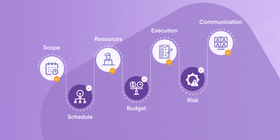10 Project Management Challenges You'll Face + How to Overcome Them
Only 47% of organizations have a track record of project success. This means over half are facing project management challenges severe enough to cause project failure.
Failing projects can lead to frustration within the project team, decrease organizational PM maturity. This means that, in the end, your projects cannot realize their expected benefits.

We all know that things rarely go to plan but, by being wise to the potential pitfalls and addressing them early, you can boost the likelihood of project success significantly.
In this article, we’ll identify the top 10 project management challenges and offer strategies for tackling them.
Let’s get started
1. Lack of clear goals
It’s vital that a specific goal is established for the project that’s communicated and agreed upon by stakeholders.
Being clear on the overall goal for the project, a mission it aims to achieve, and the benefits it’s likely to bring can create stakeholder buy-in. This makes it much easier to secure the resources required to deliver the project effectively.
The lack of a clear goal and tangible benefits is one of the biggest project management issues, as it can cause motivation for the project to wane, especially there are problems during delivery. And, without success criteria, it’s hard to understand which tasks should be prioritized and when, leading to confusion, wasted effort, and frustration.
Plus, success criteria act as a benchmark to measure progress and judge project success against. It can be hard to understand if the project is on track to deliver on time and within budget without them.
How to tackle it
Set clear objectives for the project at the start that show the benefits the project can deliver for the business. Outline the critical success factors that support each project deliverable and make sure stakeholders approve the resources needed.
Go one step further and define the criteria that will make each deliverable successful and agree on the performance indicators that will flag whether the project is on track to be successful.
During project delivery, communicate progress against performance indicators and take early action if successful delivery is under threat.
2. Scope creep
Without a clear goal for the project, you increase the likelihood of scope creep. Scope creep — where the number of project deliverables initially agreed increases — is one of the biggest challenges in the project planning process.

Practitioners named frequent changes in scope as one of the most significant project management challenges.
The biggest problem with scope creep is that the amount of work required increases without the additional resource to support it. This can overwhelm the project team, leading to stress and reducing the team’s productivity.
How to tackle it
Define the project’s scope early, stating what will be delivered and, just as importantly, what won’t be.
Have the scope agreed by senior stakeholders, including the project sponsor and the project board, who have overall accountability for the project.
Ensure the scope is clearly outlined in the project documentation. If additional deliverables are added during the project design or delivery phase, use that documentation to flag to senior stakeholders where the scope has increased.
A changing project scope is common and can be accommodated as long as additional resources are secured for its delivery.
If, for example, you're working on an eCommerce website, you can consider WooCommerce plugins as an additional resource.
If an increased scope is agreed upon, make sure the project budget or deadline also grows to match it. Use your favorite project management tools to make sure you stay within scope.
3. Lack of team communication
Lack of communication in project management can lead to frustration, duplicated or missed tasks, and inefficient workflows where tasks are tackled out of order, impacting dependencies.
Lack of communication can also affect resource management. If project team members don’t communicate their skills and experience, they may be given tasks less suited to them, reducing the team’s productivity.
And, if project progress isn’t effectively communicated, motivation within the project team can drop, reducing productivity levels further.
How to tackle it
Make sure that effective communication channels are set up to facilitate collaboration between team members. Start by creating an onboarding process for new employees, Utilize both formal communications mechanisms — such as a weekly progress meeting — and more informal approaches. Remote working can be difficult if not handled efficiently but, with the right team management tools, your levels of communication will go sky-high.
Visibly display the project plan and timeline in a shared meeting space so that everyone can see who’s working on what, how tasks hang together, and how they contribute to the overall project goal.
If possible, use tools, such as project management software, to support effective communication. Make sure there’s a central place for document storage that’s accessible to all and encourages document sharing and annotation. Record your screen with a tool like ScreenRec if you’re not in the same room or you’re working in a remote team. This can make all the difference and help you cut a lot of your email load.
Also, make sure that project progress is communicated and celebrated so team members can see how their work is making a difference.
Finally, consider using team building or social events to create an environment where people feel confident collaborating and asking for support when they need it.
4. Lack of competency
When it comes to team issues in project management, lack of competency is one of the big ones. Often projects are delivered alongside core operational work. This can mean that people are pulled onto projects that don’t necessarily have the right skills or experience for the role.

Or, if the project is poorly planned or delayed during delivery, essential resources may not be available at the required time, leaving less-experienced team members to complete the work.
How to tackle it
At project initiation, the project manager should flag what resources are required for successful project delivery. This should include a competency matrix that explains the skills and experience needed for each role.
If there’s a skills deficit between what’s required and how the project is resourced, this should be flagged to the project sponsor, who is ultimately accountable for the project’s success.
For example, some of your team members may be great at presentations but not so efficient at technical skills like opening a PDF as a Google Doc. This doesn’t mean that they aren’t useful, it just means that they need to be given responsibilities for which they can meet expectations.
Extra time should be built into the project schedule to allow for additional training, shadowing of more experienced team members, and slower project progress while less-experienced team members get up to speed.
Providing team members with access to online learning resources like Masterclass or StuDocu can also prove to be helpful for upskilling.
5. Budgeting issues
Along with scope, project success is determined by time and budget. These are the three common project management issues that need to be juggled. If the project scope is increased or tasks are delayed, there can be a significant impact on the project budget.
The budget secured to deliver the project is likely to be finite, which means the project is in jeopardy if funds run out. Only 43% of projects come in on budget, which cuts into the level of financial benefits the project offers.
Over-running budgets may also reduce confidence in likely project success.
If funds are released in stages, poor budget management in the current stage can impact funding for subsequent project phases. Reduced confidence may result in stakeholders cutting their losses and projects being closed early.
How to tackle it
Make sure you set a realistic budget during the project planning phase. Consider the project scope and expected deliverables and calculate the resources required to deliver against them.
Create a small buffer within the project budget to help manage delays or challenges securing resources.
Track actual costs against forecast costs closely and flag issues early. If the budget is tight, prioritize critical success factors and key deliverables and strip away any “nice-to-haves”.
If the scope of the project changes, make sure you recalculate the required budget and approach the project sponsor for increased funding to deliver the new work.
6. Unrealistic deadlines
As the third side of the iron triangle, feeling like there’s not enough time to get everything done is a common project management challenge.

The statistics around projects that are completed on time are pretty damning, with only 29% successful meeting their deadline.
The chance of over-running projects is greater when stakeholders have unrealistic expectations about how long project tasks may take. The consequences of ineffective project scheduling can spill out in many directions. Unrealistic deadlines can put pressure on resources, make scheduling difficult, and cause a significant amount of stress within the project team.
How to tackle it
Work closely with stakeholders to set a realistic deadline for project completion. Make sure the scope is well-articulated so it’s clear exactly what needs to be completed and in what order.
Provide evidence of how long tasks have taken on similar projects to help manage stakeholder expectations. If the project deadline is non-negotiable, try to secure extra resources to help manage the tasks according to the schedule.
During the project life cycle, track the time spent on tasks to provide information for future projects. And make sure to flag any likely deadline problems to the project sponsor at the earliest opportunity.
7. Lack of accountability
Accountability is about taking action to get things done knowing that, if they don’t get done, you’re responsible for the consequences.
When ownership is lacking, people worry less about work being missed or duplicated because they’re unconcerned with the fallout.
This means that a lack of accountability can contribute to project delays, inefficient resource use, confusion, and frustration among team members.
How to tackle it
Creating a RACI matrix can be a helpful way to clearly show where task accountability lies.
It shows who is ultimately accountable for task delivery, who’s responsible for getting work done, and which other stakeholders need to be consulted or informed.
Those accountable for deliverables need to work closely with the people responsible for completing the work to motivate them and smooth out any problems.
Senior management needs to ensure that task owners are held accountable if tasks aren’t successfully completed.
For contractors, that may mean dismissal or loss of bonuses, and for permanent employees, it may be flagged during performance review.
Equally, senior management should reward those who were accountable for successfully completing tasks.
8. Poor risk management
Risk management was voted the second-highest project management process in terms of value to the business.

So it’s not surprising that over 60% of project managers engage in some form of it.
Inadequate risk management means you’re less able to respond effectively to risks and leaves you open to regulatory or compliance issues.
Without an ability to mitigate or proactively tackle project risks, you’re left, at best, firefighting and, at worst, with a failed project.
The consequences may be anything from inefficient resource use to a significant negative impact on business operations, reputation, or financial stability.
How to tackle it
Make sure you establish a risk register. A risk register identifies things that could go wrong with the project and affect its overall success.
Risks on the risk register can be categorized by their likelihood of occurring and the impact the risk would have if it occurred.
Assign each risk an owner who is responsible for monitoring the risk and updating the risk register if anything changes. The risk owner should also develop mitigation options that can be put in place to limit the fallout should the risk become an issue.
9. Limited stakeholder engagement
Without engaged stakeholders, it’s a battle to secure the support you need for project success.
Senior stakeholders will be less interested in providing the funding or staffing required to meet deliverables, and the entire project may fail to even get off the ground.
Stakeholders need to be convinced of the value of the project so they’re confident in investing in it, especially when there may be competing initiatives.
How to tackle it
It’s essential to articulate the project’s value. Use language that stakeholders will understand, such as explaining how project success impacts their performance indicators and benefits their teams.
Build an effective communication plan to keep stakeholders engaged throughout the project’s lifetime. Schedule regular updates to make sure the project remains visible.
This is especially important when you’re working on a visual project. For example, if you’re working on the production of explainer videos, it makes sense to show your work in progress. The same goes for when you’re building a website or preparing a rebranding campaign.
In these cases, it’s a good idea to update your stakeholders with video email so that you can show them exactly how much progress you’ve made.
Consider analyzing stakeholders using a stakeholder assessment matrix to focus your communication efforts on those who are most interested or influential.
These stakeholders can help champion your project and build support for it among less-engaged stakeholder groups.
10. Poor resource management
Effective resource management is basically about two things, capacity and competency. You need to have the right people available at the right time to get the job done effectively.

Poor resource management is one of the consequences of poor project planning and it means a gap in one of those two elements.
If you don’t plan your resource use well, you may not secure the skills you need at the right time in the project. This can lead to project delays or team members becoming overwhelmed as they scramble to pick up the slack.
Or you might end up wasting money as expensive contractors sit around twiddling their thumbs because they were recruited too early.
How to tackle it
Good resource management requires effective planning. Building a robust project schedule will help you to identify which tasks need to be delivered when.
Once you’re clear on what needs to be delivered, you can determine the necessary capability and capacity to complete the tasks.
At this point, you’ll want to compare what you need with the resources you have available. If there are resource issues in your project management, make sure to engage early with stakeholders who can help you secure what you need.
Whether that’s the project sponsor for a budget uplift or HR to help with recruiting, speaking to people as soon as you’ve mapped out your resourcing requirements gives you the best chance of meeting them.
Conclusion
If you’re managing a project, you’ll likely face at least one of these challenges at some point or another. But forewarned is forearmed.
By reading this article, we hope you’ve gained more clarity about the ten most common challenges faced while managing a project and how to tackle them. This should make it easier for you to spot red flags in your projects and take early action to stop problems from growing.
A crucial part of effective project management is managing people, whether that’s your team, external contractors, or senior stakeholders.





![Top Project Management Tools To Save Time [Comparison]](https://screenrec.com/assets_dist/screenrec/media/top-project-management-tools/top-project-management-tools.png)





DON’T MISS OUT
Get updates on new articles, webinars and other opportunities: